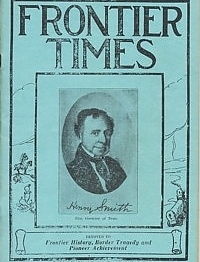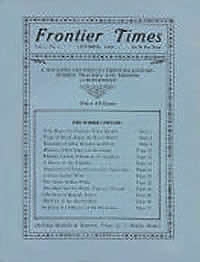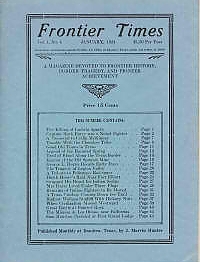By using our website, you agree to the use of cookies as described in our Cookie Policy
Magazines & Instant Downloads
Vol 08 No. 07 - April 1931
Texas Independence Won at San Jacinto (Sam Houston on cover)
General Santa Anna was very much puffed up over his victories tit the Alamo and Goliad. He thought the. Texans were conquered and that they would not dare oppose him again. But he was mistaken. He did not, yet know of what stuff the Texans were made. He divided his army into three parts and ordered his generals to sweep over the country and drive all the people across the Sabine river. The Sabine was then the boundary line between Mexico and the United States. He further ordered that all prisoners found in arms against Mexico should be shot. But San Jacinto was his waterloo and with the capture of Santa Anna the Texans won her freedom, and in due time a treaty of peace was arranged which forever lost Texas to that republic. By this treaty the Mexican troops were withdrawn from Texas, and eventually Santa Anna was permitted to return to his country. Swift riders carried the good news to all parts of the country, and everywhere there was great rejoicing. This is a great account of the memorable event.
Further Mentions: Travis and his men. the sad fate of Fannin and his men. David G. Burnet , Harrisburg, Some beeves had been killed and roasting fires kindled, when a scout came flying into camp with the news that Santa Anna was advancing up the bayou, and was not far away. General Houston immediately ordered the men into line. Hungry as they were, not a man held back. The meat was left, half cooked, the horses were quickly harnessed to the cannon and the march began. Not many miles away the San Jacinto river joins the Buffalo Bayou, and together their waters fall into Galveston Bay. It was a ferry here over which Santa Anna expected to cross into East Texas, and thither his army was hastening. Once across there would be nothing to oppose him, and the whole of East Texas would be at his mercy. Knowing this Houston urged his men forward at their utmost speed. On, on, sped the Texans, never halting once -until the ferry came in sight. Great was their joy when they learned that the Mexicans had not yet come in. Houston pitched his camp near the bank of the river in a beautiful grove, and waited the approach of the enemy. The troops were formed for battle and the "Twin Sisters" placed in position Colonel Neill, the commander of the "Twin Sisters"…It was three o'clock in the afternoon when Houston ordered the troops to parade. The men were in, high spirits, and their officers could hardly restrain them from rushing headlong into the enemy's camp. The moment had at last come. Houston ordered the charge and sounded the war-cry, "Remember the Alamo!" From rank to rank the magic words flew, and then, as if from one mighty throat, a cry went tip that froze the blood of the Mexicans and chilled their hearts with terror. At that moment a rider came up, on a horse covered with mire and foam, swinging an axe over his head, and dashed along the Texas lines, crying, as he had been told to do, "I have cut down Vince's bridge-now fight for your lives and remember the Alamo." This rider was Deaf Smith, the famous scout.
Waves Lap Relics of Texas City That Storm Killed
By Mrs. Charles Riechardt. In Matagorda Bay the city of Indianola played a great part in the early days of Texas. It rose to the rank of a. great port and traded with all the cities of the world, but finally it died in 1886 as the waves came tearing in from the gulf under the lash of a hurricane and tore the buildings to pieces. In 1844, Prince Carl Solms of Germany selected a site on which to land his emigrants from the fatherland. He chose the shores of Matagorda Bay, and named the site which, lay on the land bordering the bay, Carls Haven. It was the beginning of Indianola.
Further Mentions: La Salle, Fort St. Louis, Powderhorn Bayou. In 1859 a railroad was built between Indianola and Victoria. Major Shea, Highland Cemetery.
The Salt War of San Elizario, Texas
By Colonel M. L. Crimmins. Speaks of El Paso County, Texas, and the Salt War of 1877. Accounts the causes that led up to this frightening, shameful and bloody incident. This is good early El Paso and border area trouble history.
Further Mentions: Charles R. Howard, a prominent El Pasoan, who acquired a patent on some land by the Salt Lakes, one hundred and ten miles east of El Paso, the Tularosa Salt Lakes, one hundred miles north of El Paso. George B. Zimpleman. San Elizario, Ismael Ochoa, Saragosa, Guadalupe and San Isidro, . A local politician named Louis Cardis, county judge, G. N. Garcia, The men arrested were Jose M. Juarez, a citizen of Mexico,, and Macedonio Gandera, a citizen of Texas. sheriff, Charles Kerber., Father Peter Bourgade, A. J. Fountain, the Pioneer Garage at the corner of San Francisco and Santa Fe Street, Solomon Schutz, a merchant of El Paso, Louis Cardis, Adolph Krakauer, Cisto Salcido, , J. M. Juarez, Ramon Zambrano, and Luciana Fresques, Lieutenant Louis H. Rucker, 9th U. S. Cavalry, Major John. B, Jones, Frontier Battalion State Troops., Major Jones, Charles E. Ellis, a merchant of San Elizario, Sergeant Mortimer, Howard and Tays, John Atkinson, Sergeant McBride of the State Troops, Chico Barella,, Captain Tucker, Crecinta Iragoen and Santiago Durand, Ysleta, Colonel Edward Hatch, 9th Cavalry, the killing of the Mexican, Munoz, Sergeant Frazer. Colonel John H. King, 9th Infantry, Lieutenant Colonel W. H. Lewis, 19th Infantry, First Lieutenant Leonard Hay, 9th Infantry, Sergeant Ford, the First Sergeant of. Tays' rangers, who killed Sergeant Frazer,
Lonely Grave of Belle Boyd
By Charles L. Martin. This is an amazing account of an amazing woman: Miss Marie Isabel Boyd, known as Belle Boyd, the only woman Confederate spy. She was born May 9, 1843, in Martinsburg, Va. (now West Virginia), part of the Shenandoah Valley, not far from where the immortal Stonewall Jackson was born and reared.
An excerpt: The Confederates serving in Virginia all knew of her and not a few had the honor and the pleasure of knowing her personally. If her life and career during the four years of the war were given in detail, it would read more like the broadcast, hectic imagination of a dreamer…"She knew all the risks she was running, but they did not daunt her courage, serving only to make her more determined in aiding the South and by whatever means. She even resorted to treachery. One day she went out riding with two Confederate soldiers, one her cousin. When near the Federal lines, her horse broke suddenly at full speed toward the Federal lines, she screaming for help so appealingly that the, picket guard let her pass without firing at her. Within the lines she was shown every courtesy, readily obtaining leave to return home, charmingly accepting the escort of two officers. As the three rode along, suddenly from ambush the two Confederates with ready revolvers halted them.
"Here are two prisoners I have brought you," she calmly informed her friends. The prisoners, asking the name of the lady, she smilingly replied, "Belle Boyd." "The rebel spy" was their only reply."
Further Mentions: W. A. Everman, Front Royal, Va., Gen. Turner Ashby. Lieut. Samuel Hardinge. E. Cole of Baraboo, Wis.,
The Adventures of Big-Foot Wallace
By John C. Duval. First Published in 1870. (Continued from last month) The patriot, hero and frontiersman, along with his companions endure incredible privations, thirst, hunger, torturous conditions in their effort to escape Mexican forces, only to be recaptured and march all the way back to Saltillo.
We were much depressed in spirits by the barren and desolate appearance of the country ahead of its; still there was no alternative but to go forward, for we knew if we retraced our steps we would inevitably be recaptured by our vigilant foes, and anything, we thought, was preferable to that. And we went oil all through that weary day, up one rugged, rocky mountain, and down and up another, still hoping and trusting that in some of the ravines or canyons that lay between them (for they could not be called valleys), we would, at length, come across a stream or pool of water sufficient to slake our thirst. But everywhere we were continually disappointed. No murmuring streams rippled over the sandy beds of the gulches and canyons we passed-all were parched up, and as dry as if a drop of rain had not fallen in that dreary region since the days of the Flood. And thus we struggled on till darkness closed over the scene when, abandoning all hope of finding water that dlay, we encamped for the night among the broken rocks and debris at the bottom of a deep canon.
…the suffering of the men became so intolerable that many of them, to relieve themselves of all superfluous weight, threw away their guns and equipments, and what remained of their rations of jerked meat -for hunger was not felt or feared - our whole craving -was for water! water! Many of the men gave out entirely, and laid down on. the wayside to die, but no one paid. any attention to them, for great suffering, such as we were enduring, is apt to render men callous and unfeeling toward each other, Still the rest of us struggled on, hoping that our strength might hold out until we came to water; but we toiled up one rugged, barren mountain, only to see another as; rugged and barren rise tip before us…
…with thirst …there is not a moment's cessation of the suffering but, on the contrary, it increases regularly in intensity, until the tongue becomes black and swollen- and protrudes from the mouth, and the eyes bloodshot and bleared, seem as if they are about to part from their sockets. Even sleep affords no respite whatever from this terrible anguish. Horrible shapes gibber and moan around the wretched slumberer, and frighten him away from the gushing spring or rippling brook, that forever haunts his mind, waking or sleeping. (Continued next month)
HOME OF GEN. SAM HOUSTON
Brief article on the home of the great hero, soldier, statesman and 2nd president of TX
Chihuahua Trail, Linked U. S. and Mexico
By R. Franklin Hall. Great article on the ways and means of freighting in early TX. Further Mentions: Henry Skillman, Dr. H. Connelly, John Monier, Mr. Staacke, who ran an implement and vehicle store on West Commerce Street. Rocke Garady, David & Daniel Sada, Harden B. Adams, E. D. L. Wickes, Nat Lewis, Sr., Groesbeck, Edward Froboese, Peter Jonas, Henry 'Bitter, Louis Oge, Anastacio Gxonzafes, Enoch Jones and John Gargip of San Antonio. John Gargin had the finest outfit in the Southwest. He ran 12 wagons of 14 mules each. Julimes, Bachamba Ranich, Santa Eulalia Mine, August Santleben, General Ord, Mr. Lockwood,
The Chihuahua Trail ended in 1877, when the G. H. & S. A. was completed into San Antonio. In 1,883 trains were running through to San Francisco over the Sunset Route. In 1885 the railroad was completed to Laredo, where it connected with the Mexican Central.
Uncle Dick Bussell, Champion Buffalo Hunter
By Mary Daggett Lake, Fort Worth, Texas. Story of long-time Canadian resident (he helped to survey the town in 1887), "Uncle Dick" Bussell, who speaks of early days in the Panhandle. I once told a man I had killed about a hundred thousand buffalos, but that was too many. I later figured it out that I killed more than fifty thousand in the ten years I was in the business, from 1867 to 1877.
"Guess you knew that Charles Goodnight brought the first cattle to the Panhandle in about 1877. 1 killed one of his steers once by accident, shooting in a herd of buffalos. The steer was in the bunch. I did not know it until one of my men brought it to me. About all we did was eat buffalo meat. Best meat in the world. Seems like things now-a-days don't taste like they used to. Lots of things you see advertised look good, but they have no taste. Once I saw some buckwheat advertised-a great big picture with cakes, and syrup poured all over 'em. I thought I would like some, so I bought some of the buckwhreat. It tasted no more like buckwheat than dirt. We used to raise buckwheat. I know good buckwheat. It sure is fine.
Further Mentions: old-timers left that were here when Fort Elliott was established in 1875. George Black, Mark Hustlebee, Paul Cochran, Milo O’Laughlin, The Battle of Adobe Walls, Charles Rath and Bob Wright, Leonard & Myers, James Hanrahan had a saloon, Cheyenees, Kiowas and Comanches, with Quanah Parker, the son of Cynthia Ann, leading the Comanches,
This Generation Knows Nothing of Hardships
Story of Mrs. MARY FRANCES BOYLE of Jean, who knows something of hard times. She was among the pioneers who came from the older states and did her share in building up Texas in the days when courage, determination, and self-reliance were necessary in establishing homes on the frontier. Her life has been an eventful one. She was born in Talladega county, Alabama, in 1837, and came to Limestone county, Texas in 1870.
The most popular form of recreation for girls as well as boys at that time was riding and roping the Texas longhorns, and Mrs. Boyle says that she could rope and tie a steer about as quick as the boys. Davy Crockett's View Of It
Peter Molyneaux. Inside look at an event in Congress which showed the power of the great frontiersman’s personality and unusual political style.Salado, One Of Oldest' Of Frontier Towns, Was Once Near Being State Capitol
Albert Nibling, Jr. Salado, one of the oldest of Texas towns, once missed being the capitol of Texas by only two or three votes, stands today with little that would hint of its former greatness – Further Mentions: Salado creek, old Thomas Arnold academy, the ruins of which cover the hill just south of Salado's business center today. Sterling C. Robertson, guiding light of Salado at its earliest period, The
Capture of Daniel Webster
H. W. Baylor. Interesting account of the capture of the black murderer.
Buried Treasure
By Judge J. -M. Deaver, El Paso, Tex.
There has arisen many stories and legends concerning the buried treasure connected with the old Spanish mission on the San Saba river near Menard, and it has only been in the last few years that the true location and true history of that marvelous fortune has been unearthed.
Indian Stronghold is Now Peaceful Texas Town
By S, Kirgan, in Houston Chronicle. One of the most picturesque and interesting, little towns in Texas is Tehuacana. Located on a rise of hills, it commands an incomparable panoramic view of many miles of blue distance. This quaint little community, 50 miles east of Waco, was the scene of one of the most violent clashes of the early days, a battle between the Cherokees and the Tehuacanas, from which only 12 of the Tehuacanas escaped. On the top of the highest, hill, overlooking the town, is Westminster College. Founded in 1869, it is one of the oldest institutions in Texas. There, on that ridge, the great battle of The Cherokees and the Tebuacanas bad been fought. This account told by Rev. J. W. Pearson, who was born in Coosa county, Alabama, September 8, 1852, and moved to Texas in December, 1869, settling near Bryan, in Brazos county. He moved to Austin in 1874, and then to Limestone county in 1879, and entered Trinity University in September of that year as a student for the ministry of the Cumberland Presbyterian denomination. He was graduated in 1884, and was married to Miss Kate, George in 1886. He spent over 55 years in Tehuacana.
Further Mentions: Major John Boyd, Battle Creek fight, Dawson, in Navarro county, the town of Franklin, in Robertson county, Capt. William M. Love. Tolmacana Hills,
Seventy-Five Years Ago Bosque Was an Indian Trail
Exciting first-hand story and great early Bosque Co. History.
"The following is a sketch of an Indian scare we bad in Bosque county in the spring of 1853. In that year I lived in what is now known as the Norwegian settlement. I had several Norwegian neighbors. The nearest was Ole Canuteson, the next Ore Ween (a bachelor), and then Canute Canuteson (Ole's father). Ole Henson lived at the head of Gray's Creek, ten miles above any other settler..
Further Mentions: Jasper N. Mabray, one of the organizers of Bosque county. Col. Frazier who lived right where Kimball is now. old man McCurry, Mrs. Martha Randal ,Arch and Frank Kell , . F. M. Kel, the Lockers who lived where Clifton is now situated, Gray's Creek, Neill's Creek, Pearson, Isaac Gary and Govey Gary, Glen Rose, an Indian raid we had in the spring of 1854, the Morgan News, J. K. Helton of Meridian;, and John Thomas, of Valley Mills, the old Scrutchfield Ranch, Joe Barton, a man by the name of Chesser, J. K. Helton, Helton, John Thomas, Valley Mills, and the Everett's and Lowery Scrutchfield. the Rhodes settlement on Middle Bosque, Abe Flanery, Panten Bill Edwards, Clusen Needham. Hog Creek, Finley Bloodworth, George B. Erath, J. K. Helton, of near Meridian and John A. Thomas, of Valley Mills
SOME NAMES MENTIONED IN THIS VOLUME:
Harden B. Adams; Desiderio Apodaca; Thomas Arnold; Gen Turner Ashby; John Atkinson; Austin; Baker; Chico Barella; Joe Barton; A. S. Baylor; A. S. (Searce) Baylor; Lee Bertillion; Henry Bitter; George Black; Capt Blair; Sam Houston Blankenship; Finley Bloodworth; Father Peter Bourgade; Belle Boyd; Belle (Marie Isabel) Boyd; John Boyd; Maj John Boyd; Marie Isabel Boyd; George O. Boyle; Mrs Mary Frances Boyle; Benjamin F. Maj Bryant; Burnet; Dick (Richard Bussell) Bussell; Richard Bussell; Caldwell; Cameron; Andrew Canuteson; May Ole Canute; Louis Cardis; Lt Carter; Tom Chewning; Grover Cleveland; Paul Cochran; H. E. Cole; Dr H. Connelly; Col Corcoran; Crimmins; Col Crockett; Fred W. Davis; Judge J. M. Deaver; Henry Dillard; Dixon; Santiago Durand; Panten Bill Edwards; Charles E. Ellis; George B. Erath; W. A. Everman; Gen Flaco; Abe Flanary; Abe Flanery; Sgt Ford; Jenny Foster; A. J. Fountain; Sgt Frazer; Col Frazier; Luciana Fresques; Edward Froboese; Macedonio Gandera; Rocke Garady; G. N. Garcia; John Gargin; Grover Gary; Isaac Gary; Gillett; Anastacio Gonzales; Goodnight; Mrs Joes Groves; R. Franklin Hall; James Hanrahan; Lt Samuel Hardinge; Simeon Hart; Col Hatch; Edward Col Hatch; Lt Leonard Hay; Hayes; Hays; J. K. Helton; Ole Henson; Gen Hood; Pres Hoover; ; Charles R. Judge Howard; Hubbard; Hunter; Mark Hustlebee; Crecinta Iragoen; Stonewall Jackson; F. Johnson; Peter Jonas; Enoch Jones; J. M. Juarez; Jose M. Juarez; Arch Kell; F. M. Kell; Frank Kell; Jeff T. Kemp; Charles Kerber; Sheriff Kerber; Col John H. King; S. Kirgan; Adolph Krakauer; Chevalier La Salle; Robert Rene La Salle; Mary Daggett Lake; Lehmann; Lemley; Nat Lewis Sr; Col W. H. Lewis; Abe Lincoln; Longley; Capt William M. Love; Jasper N. Mabray; Charles L. Martin; Jim Mast; Maverick; Peter Molyneaux; John Monier; Sgt Mortimer; Clusen Needham; Col Neill; Albert Nibling Jr; Ismael Ochoa; Louis Oge; Milo O'Laughlin; Gen Ord; Parker; Dr Pearson; J. W. Pearson; Mrs Martha Randal; Charles Rath; Mrs Charles Riechardt; Roberts; Gordon Robertson; T. D. Robinson; Rose; Lt Louis H. Rucker; Daniel Sada; David Sada; Cisto Salcido; Earl San Saba; Salvina; Santa Anna; August Santleben; Saunders; Solomon Schutz; L. S. Scrutchfield; Lowery Scrutchfield; Maj Shea; Henry Skillman; Prince Carl Prince Solms; A. Talamantes; Lt Tays; Jesus Telles; Telles; Mrs Salome Telles; John Thomas; John A. Thomas; Capt Tucker; Riley Walker; Wallace; Henry Warren; Daniel Webster; Ole Ween; E. D. L. Wickes; Wilbarger; Mrs Roxiana Wilkes; T. Williams; Woodrow Wilson; Bob Wright; Ramon Zambrano; George B. Zimpleman; Zimpelman
$4.95
‹ Back








